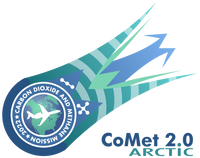Carbon Dioxide and Methane Mission for HALO 2.0 Arctic-
CoMet 2.0 Arctic
Research campaign on greenhouse gases in high latitudes
Mission Time Period: August - September 2022, completed
More and updated information: https://comet2arctic.de/
Principle Investigator
Partner Institutions
- German Aerospace Center, Institute of Atmospheric Physics (DLR-IPA), Oberpfaffenhofen
- Max Planck Institute for Biogeochemistry (MPI-BGC), Jena
Universität Bremen, Institute of Environmental Physics (IUP-UB)
Ludwig-Maximilians-Universität München (LMU), Meteorological Institute Munich (MIM)
- German Aerospace Center, Flight Experiments (DLR-FX), Oberpfaffenhofen
Project Description
The goals of CoMet 2.0 are to extend the studies of the first successful CoMet mission, that was conducted in 2018, to regions outside of Europe, in particular to wetlands and biomass burning areas. Here, quantifying changes in CH4 emissions is complicated since emissions from wetlands and biomass burning are dispersed over large areas, with emission rates that vary significantly inter-annually. Particularly, the role of wetlands in the terrestrial carbon cycling is complex. Wetlands cover between 4 – 9 % of the global surface area but store almost 40 % of the global terrestrial carbon. Under anaerobic conditions – combined with decomposition of organic matter – CH4 is produced, making the wetlands the largest single source of atmospheric methane, even when considering all anthropogenic emissions. At the same time, natural wetlands, both boreal and tropical, have the largest absolute uncertainty (> 100 Tg CH4 yr-1) of any of the emission categories, and seem to be the dominant source of discrepancies in modelled CH4 emissions.
The current paucity of appropriate observational datasets presents a large obstacle to improve our understanding and ability to model global wetlands (Melton et al., 2013). It is therefore generally accepted that aircraft measurements, in combination with chemical transport models, will help to reduce the uncertainty of global wetland CH4 emission estimates.
Such data sets on the spatial scale of wetland basins, to complement local measurements and data from an emerging fleet of GHG measuring satellites, are still rare. Here, they will be used for an inverse modelling approach using high resolution atmospheric models (e.g., WRF), in combination with wetland models for regional budgeting.
CoMet 2.0 consists of two parts, which will be conducted in the Arctic and in the Tropics, where the largest boreal and tropical wetlands are located. The Arctic campaign will take place in Canada from August to mid-September 2022. In spring of one of the following years, the Tropic campaign is planned to be run in Brazil.
The payload of the CoMet mission will be extended with the integration of the new MAMAP2D instrument. This 2-dimensional imaging spectrometer system measures CO2 and CH4. It is the successor instrument of MAMAP which was flown on the Cessna 207 during CoMet. Including these measurements on the same platform with the other remote sensing (CHARM-F, mini-DOAS) and in situ (JIG, JAS) instruments facilitates further synergies for data analysis. Furthermore, the core payload will be complemented by a quantum cascade laser spectrometer to measure ethane (C2H6), a tracer for emissions from oil and gas emissions.
Beyond the scientific goals, those activities will continue the preparation of the validation activities of the German-French climate mission MERLIN.
Payload of HALO during CoMet 2.0 Arctic
Cabin Plan of the CoMet 2.0 Arctic Payload onboard HALO

